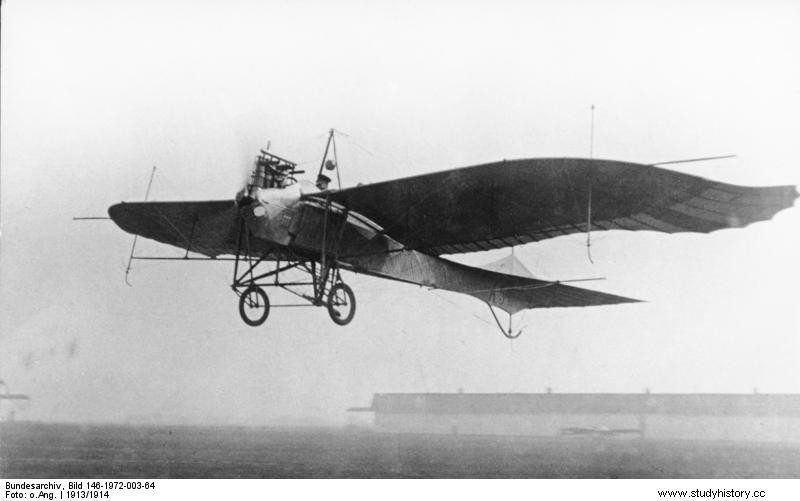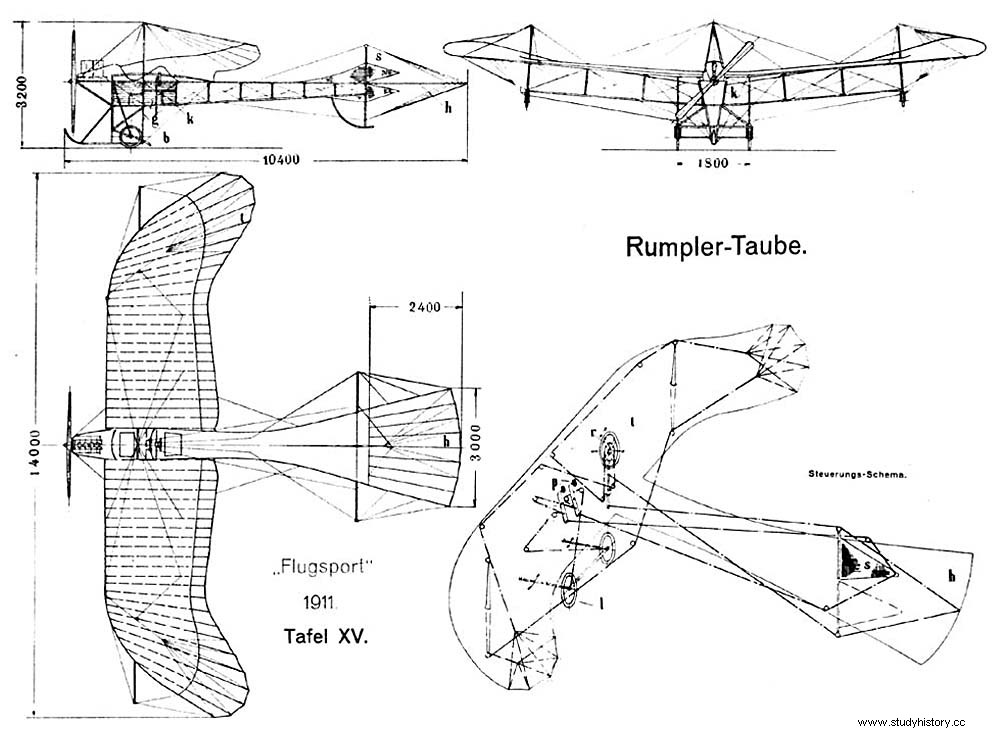
November 1, 1911, Italy was in the midst of the Italian-Turkish war, and Giulio Gavotti , an Italian aviator, on this date at the first light of dawn left aboard his own Etrich Taube monoplane , a German-made monoplane, officially for a reconnaissance operation which, thanks to the individual initiative of the aviator, became the first aerial bombardment in history.
It must be said that, before 1911, the airships had already been used for offensive operations, and therefore there had already been " aerial bombardments "However, in 1911, for the first time, the offensive was carried out by a plane-plane and not by an airship, and it is precisely the use of the plane-plane that was the novelty that would change forever the face of war, marking a point of no return in war operations.

We have a lot of information and numerous sources of the 1911 air raid during the Italian-Turkish war, one in particular allows us to reconstruct those moments, through the direct testimony of Giulio Gavotti, at the time a simple airman who had recently finished his student course. officer in Turin with the 5th regiment “Genius Miners” , after this operation, Gavotti's career would take off bringing him up to the rank of Lieutenant Colonel, but that's another story.
The detailed account of the events of November 1 is provided by Gavotti, as well as from the official mission report, also from a more interesting letter, addressed to his father and which, given the wealth of information on the flight, is presumed to have been written on the same day. of November 1, 1911. In this letter Gavotti writes.
"Ho deciso di tentare oggi di lanciare delle bombe dall'aeroplano. È la prima volta che si tenta una cosa di questo genere e se riesco sarò contento di essere il primo."
From these first words we can observe that Gavotti is perfectly aware of what he is about to do, his goal is to show off with his superiors, he is perfectly aware of what he is about to do and, at the expense of what many they think, his action was not improvised, but rather, it was planned, if it is not very clear how many of Gavotti's superiors actually knew of his intentions. A certain lexical ambiguity emerges from the mission report, and probably his was a clandestine operation or in any case.
The text of the letter, however, continues saying that it would be that morning of November 1st he had left at the first light of dawn "As soon as it is clear I'm in the field. I'll take my device out. " He then adds that, in the passenger compartment, if you can call it that, he nailed a leather container "I nailed a small leather box next to the seat; I bundle it internally with cotton wool and carefully lay the bombs on it. ”
We understand, from these words that it is all very amateur, perhaps too amateur, however, it is strange and unclear, how the airman Gavotti managed to get hold of four Cipelli bombs. “These bowler hats are spherical and weigh about a kilo and a half. I have three in the box; the other I put in the pocket of the leather jacket. " in this passage we are given very significant information on the type of ordnance at its disposal, it is, as anticipated, three "Cipelli" bombs, the only bombs supplied to the royal army in 1911, spherical in shape to have the weight of about 1.5Kg and, the next step further confirms us to be Cipelli bombs, as it tells us "In another pocket I have a small cardboard box with four mercury fulminate detonators within four" and, the Cipelli bombs, were activated by external detonators that had to be combined with the bomb so that it could be triggered, unlike other bombs that instead had an integrated detonator.
Gavotti then provides us with a series of more or less detailed information on his position and on his itinerary " ... I arrive above the" Sicily "anchored to the west of Tripoli opposite the oasis of Gurgi then I go back step over the" Brin ”, The“ Saint Bon ”the“ Filiberto ”on the steamers anchored in the bay . ", But the most interesting information concerns the altitude at which he would have flown, " When I have reached 700 meters I head inland "
Gavotti tells us to fly at an altitude of about 700 meters , and which takes altitude on the sea and then follows its own itinerary in the hinterland, beyond the enemy lines, these data are very interesting because they tell us a lot about the flight and what is somehow the mood of the aviator, we in fact, they communicate excitement but also determination and tension, as well as the desire to succeed in the enterprise and this desire for success translates into the decision to fly at low altitude or at about 700 meters, probably to be able to hit targets with greater precision.
An Etrich Taube monoplane of the time, according to technical information from Igo Etrich , it could fly up to 2000 meters of altitude, but it could go even higher and for the reconnaissance operations, it was generally planned to fly at about 1500 meters, almost at the limit of the possibilities of the Taube.
The letter continues and from here on, it looks more like a mission report than an informal letter to his father, Gavotti writes "I cross the line of our outposts located on the edge of the oasis and I go into the desert in the direction of Ain Zara more a small oasis where I had seen the enemy camps (about 2000 men) in the days before . "
Arriving at the oasis Gavotti prepares for the offensive action "With one hand I hold the steering wheel, with the other I untie the corregile that keeps the lid of the box closed; I take out a bomb and place it on my lap. ” then “I change hand at the wheel and with the free one I take a detonator out of the box and put it in my mouth. I close the box; ”
The action that is described to us is extremely cinematic, it is a scene that we have seen in hundreds of films, there is this young aviator, alone in the skies above the fields of the enemy who with one hand pilots his own aircraft and with the on the other, he extracts the first device, triggers it and looking out of the plane-plane tries to identify a possible target "I put the detonator in the bomb and look down. I'm ready."
Gavotti is very close to the enemy, he tells us in the letter, that he is about a kilometer from the oasis and is already able to identify the silhouettes of the Arab tents, "I see two camps near a white square house, one of about 200 men and, the other about 50. "
This information is for some too accurate for the distance that, according to the letter, separated him from the camp at that time, we do not know if this is an estimate and therefore Gavotti has seen the camps and hypothesized the number of men who, on the basis of the their own experience, they could be in the field, or if instead it is a narrative expedient, aimed at emphasizing the moment, after all, it is still a letter to the father and not a real mission report. There is no reference to this almost acrobatic passage in the mission report.
In any case, the letter continues “Just before I get on it I grab the bomb with my right hand; with my teeth I tear out the safety key and throw the bomb out of the wing. I can follow it with my eye for a few seconds then it disappears. After a moment I see a dark cloud right in the middle of the tent. ”
The action continues to be extremely cinematic, we see this pilot who rips the safety key of the device and throws it out of the cockpit and then sees it vanish, due to the small size of the device and the increasing distance between the device and the 'airplane, but then, here comes the decisive moment, the bomb touches the ground and explodes, the pilot sees a cloud of black smoke rising from the field, the explosion exalts the aviator and at the same time upsets the balance of the camp, who certainly did not imagine what was happening. Nothing like this had ever happened before, before then no reconnaissance plane had ever dropped bombs.
Gavotti's story continues and gives us other information, he tells us that despite the success the objective he had aimed at was actually missed, but nevertheless he is satisfied with the result and therefore decides to repeat the experiment, throwing other bombs. “I really had aimed the big one but I was lucky all the same; I hit it right. I review several times and throw two more bombs, but I cannot see the effect. I have one more left that I launch later on the Tripoli oasis itself. "
In this passage Gavotti told us something that actually we already knew, this type of action carries with it a lot of imprecision, Gavotti was lucky, very lucky, probably his knowledge of the laws of physics allowed him to estimate and calculate by eye the exact moment in which to launch the device so that it could get as close as possible to the target.
In fact, knowing the height, speed and direction of the plane, for an engineer with an aviator training it should not be too difficult to calculate the trajectory of the launch, and it so happened that Gavotti was just an engineer with an aviator training and probably this same action, carried out by any other airman, would not have had the same result.
These fortuitous coincidences we do not know how fortuitous they are and how much coincidences they are, as far as we know, the whole operation was an individual action, but we can imagine that perhaps, Gavotti was chosen, precisely for the whole of his experiences, as the ideal sample for this test.
From the letter to his father Gavotti he appears very satisfied with the success achieved and anxious to report the outcome of the operation to his superiors "I am very happy with the result. I go straight to the division to report and then to the Governor gen. Caneva. Everyone is very satisfied ”
The last words of the letter are very particular and interesting, if it were an individual initiative Gavotti would be guilty of stealing bombs, of carrying out an offensive action without authorization and of putting a plane of the Royal Army at risk, all factors that they would have brought him to court martial, but we know that Gavotti was celebrated as a hero of that war and that he received, for his actions, a silver medal for military valor, and this leads us to assume that, despite not written orders exist, this operation was authorized from above. Album of the Pioneers of Italian Aviation , Rome 1982 Printed at Typolithography of the Application School A.M. - FI 1982.
Mechanical sports , Rome, May 15, 1933;
G. Dicorato, G. Bignozzi, B. Catalanotto, C. Falessi, History of Aviation , Milan, Fratelli Fabbri Editori, 1973.
R.G. Grant, (Italian ed. By R. Niccoli), Il volo - 100 anni di aviation , Novara, DeAgostini, 2003,
